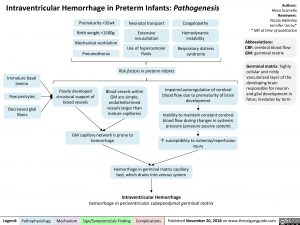Intraventricular Hemorrhage in Preterm Infants: Pathogenesis
Authors: Alexa Scarcello Reviewers: Nicola Adderley Jennifer Unrau* * MD at time of publication
Abbreviations:
CBF: cerebral blood flow GM: germinal matrix
Germinal matrix: highly cellular and richly vascularized layer of the developing brain responsible for neuron and glial development in fetus; involutes by term
Prematurity <32wk Birth weight <1500g
Mechanical ventilation Pneumothorax
Neonatal transport
Extensive resuscitation
Use of hyperosmolar fluids
Risk factors in preterm infants
Coagulopathy
Hemodynamic instability
Respiratory distress syndrome
Immature basal lamina
Few pericytes
Decreased glial fibers
Poorly developed structural support of blood vessels
Blood vessels within GM are simple, endothelial-lined vessels larger than mature capillaries
Impaired autoregulation of cerebral blood flow due to prematurity of brain development
Inability to maintain constant cerebral blood flow during changes in systemic pressure (pressure passive system)
↑ susceptibility to ischemia/reperfusion injury
GM capillary network is prone to hemorrhage
Hemorrhage in germinal matrix capillary bed, which drains into venous system
Intraventricular Hemorrhage
hemorrhage in periventricular subependymal germinal matrix
Legend:
Pathophysiology
Mechanism
Sign/Symptom/Lab Finding
Complications
Published November 20, 2018 on www.thecalgaryguide.com
Foundations
Systems
Other Languages
Pediatrics Sick Neonate Intraventricular Hemorrhage in Preterm Infants: Pathogenesis IVH Intraventricular Hemorrhage in Preterm Infants – Pathogenesis

